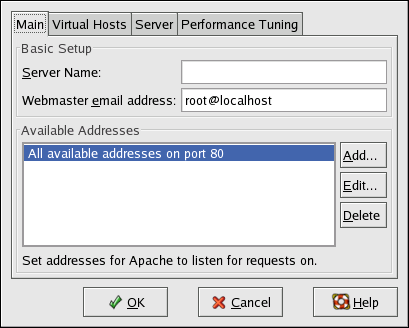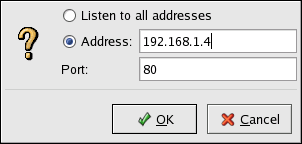Chapter 24. Apache HTTP Server Configuration
Red Hat Enterprise Linux provides version 2.0 of the Apache HTTP Server. If you want to migrate an existing configuration file by hand, refer to the migration guide at
/usr/share/doc/httpd-<ver>/migration.html or the Reference Guide for details.
If you configured the Apache HTTP Server with the HTTP Configuration Tool in previous versions of Red Hat Enterprise Linux and then performed an upgrade, you can use the HTTP Configuration Tool to migrate the configuration file to the new format for version 2.0. Start the HTTP Configuration Tool, make any changes to the configuration, and save it. The configuration file saved will be compatible with version 2.0.
The
httpd and system-config-httpd RPM packages need to be installed to use the HTTP Configuration Tool. It also requires the X Window System and root access. To start the application, go to the => => => or type the command system-config-httpd at a shell prompt (for example, in an XTerm or GNOME Terminal).
The HTTP Configuration Tool allows you to configure the
/etc/httpd/conf/httpd.conf configuration file for the Apache HTTP Server. It does not use the old srm.conf or access.conf configuration files; leave them empty. Through the graphical interface, you can configure directives such as virtual hosts, logging attributes, and maximum number of connections.
Only modules provided with Red Hat Enterprise Linux can be configured with the HTTP Configuration Tool. If additional modules are installed, they can not be configured using this tool.
Warning
Do not edit the
/etc/httpd/conf/httpd.conf configuration file by hand if you wish to use this tool. The HTTP Configuration Tool generates this file after you save your changes and exit the program. If you want to add additional modules or configuration options that are not available in HTTP Configuration Tool, you cannot use this tool.
The general steps for configuring the Apache HTTP Server using the HTTP Configuration Tool are as follows:
- Configure the basic settings under the Main tab.
- Click on the Virtual Hosts tab and configure the default settings.
- Under the Virtual Hosts tab, configure the Default Virtual Host.
- To serve more than one URL or virtual host, add any additional virtual hosts.
- Configure the server settings under the Server tab.
- Configure the connections settings under the Performance Tuning tab.
- Copy all necessary files to the
DocumentRootandcgi-bindirectories. - Exit the application and select to save your settings.
24.1. Basic Settings
Copy linkLink copied to clipboard!
Use the Main tab to configure the basic server settings.
Figure 24.1. Basic Settings
Enter a fully qualified domain name that you have the right to use in the Server Name text area. This option corresponds to the
ServerName directive in httpd.conf. The ServerName directive sets the hostname of the Web server. It is used when creating redirection URLs. If you do not define a server name, the Web server attempts to resolve it from the IP address of the system. The server name does not have to be the domain name resolved from the IP address of the server. For example, you might set the server name to www.example.com while the server's real DNS name is foo.example.com.
Enter the email address of the person who maintains the Web server in the Webmaster email address text area. This option corresponds to the
ServerAdmin directive in httpd.conf. If you configure the server's error pages to contain an email address, this email address is used so that users can report a problem to the server's administrator. The default value is root@localhost.
Use the Available Addresses area to define the ports on which the server accepts incoming requests. This option corresponds to the
Listen directive in httpd.conf. By default, Red Hat configures the Apache HTTP Server to listen to port 80 for non-secure Web communications.
Click the button to define additional ports on which to accept requests. A window as shown in Figure 24.2, “Available Addresses” appears. Either choose the Listen to all addresses option to listen to all IP addresses on the defined port or specify a particular IP address over which the server accepts connections in the Address field. Only specify one IP address per port number. To specify more than one IP address with the same port number, create an entry for each IP address. If at all possible, use an IP address instead of a domain name to prevent a DNS lookup failure. Refer to http://httpd.apache.org/docs-2.0/dns-caveats.html for more information about Issues Regarding DNS and Apache.
Entering an asterisk (*) in the Address field is the same as choosing Listen to all addresses. Clicking the button in the Available Addresses frame shows the same window as the button except with the fields populated for the selected entry. To delete an entry, select it and click the button.
Note
If you set the server to listen to a port under 1024, you must be root to start it. For port 1024 and above,
httpd can be started as a regular user.
Figure 24.2. Available Addresses

